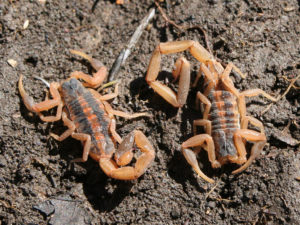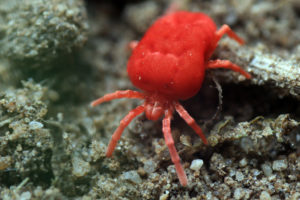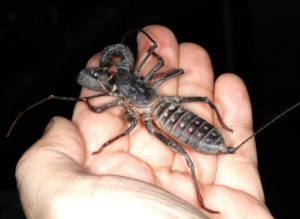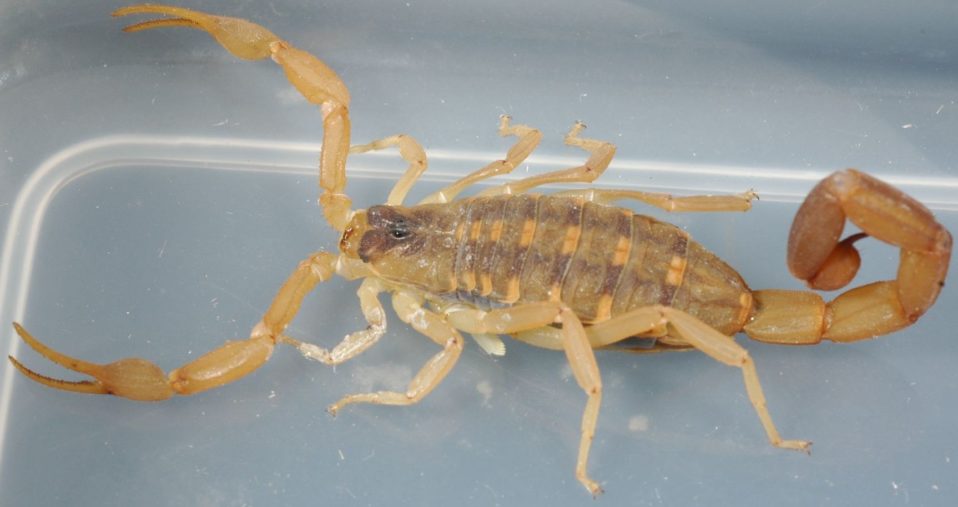Wildlife Wednesday: The Other Arachnids
Spiders aren’t the only arachnids! To honor the 2nd week of Ms. Jenny’s Spider themed Summer Science Camp, this week we’re going to look at 3 other arachnids that are found in the area. Arachnids are arthropods, invertebrate animals that have exoskeletons made of chitin and multiple jointed legs.They’re on every continent, and tend to be terrestrial, though there are several species of spider and mite that live in freshwater aquatic ecosystems. They are never found in the ocean. Here’s a look at 3 non-spider arachnids that are found in and around this part of Texas.
 One of the most commonly encountered non-spider arachnids in this part of the state is the Striped Bark Scorpion (Centrutoides vittatus). This is a small scorpion, growing to only about 2.75 inches in total length. They may deliver a painful sting, though the venom is not usually injurious to humans, beyond the obvious pain and discomfort. As with all other scorpions, this species is carnivorous, seizing their prey with front pinching claws, and injecting the prey with venom from the tail stinger. They then spit out digestive juices onto the prey, and suck up the dissolving body of the prey. Maybe a bit gross, but its what they do!
One of the most commonly encountered non-spider arachnids in this part of the state is the Striped Bark Scorpion (Centrutoides vittatus). This is a small scorpion, growing to only about 2.75 inches in total length. They may deliver a painful sting, though the venom is not usually injurious to humans, beyond the obvious pain and discomfort. As with all other scorpions, this species is carnivorous, seizing their prey with front pinching claws, and injecting the prey with venom from the tail stinger. They then spit out digestive juices onto the prey, and suck up the dissolving body of the prey. Maybe a bit gross, but its what they do!
Velvet Mites (family Trombiidae) are exceptionally small arachnids, a little bit larger than the size of a period at the end of this sentence. They are very easy to identify, with their tiny bright red furry bodies. They’re seen in a wide variety of ecosystems, crawling over vegetation, rocks, and picnic tables. These mites are active and voracious predators, hunting down a wide variety of tiny invertebrates.
T he 3rd animal we’ll look at this week is from a much lesser known group of arachnids called the “whip scorpions”, and here in the U.S. we call them Vinegaroons (Mastigoproctus giganteus). These large chunky arachnids may grow up to 3 inches long (6 inches if you count the whip tail). They’re named for the practice of squirting a vinegar-like substance from from their “tail”, which they use to deter predators and disable prey. As with other arachnids, they are predatory on a wide variety of other invertebrates. Though we do get them rarely in this part of Texas, they are far more common in the arid regions of South and West Texas.
he 3rd animal we’ll look at this week is from a much lesser known group of arachnids called the “whip scorpions”, and here in the U.S. we call them Vinegaroons (Mastigoproctus giganteus). These large chunky arachnids may grow up to 3 inches long (6 inches if you count the whip tail). They’re named for the practice of squirting a vinegar-like substance from from their “tail”, which they use to deter predators and disable prey. As with other arachnids, they are predatory on a wide variety of other invertebrates. Though we do get them rarely in this part of Texas, they are far more common in the arid regions of South and West Texas.
Now, in our park, you’ll only see spiders and mites, but make sure to keep an eye out for spiders, whip scorpions, scorpions, and velvet mites, when you’re out and about at nature centers, state parks, and national wildlife refuges around the Houston area. You might be surprised at what you’ll find.
Thanks for joining us, and see you soon!
Eric Duran
Staff Naturalist
Photographs: Top photo – Charles&Clint | Flickr; Scorpions – Douglas Mills | Flickr; Velvet Mite – Chris Fifield Smith | Flickr; Vinegaroon – Acrocynus | Wikimedia



